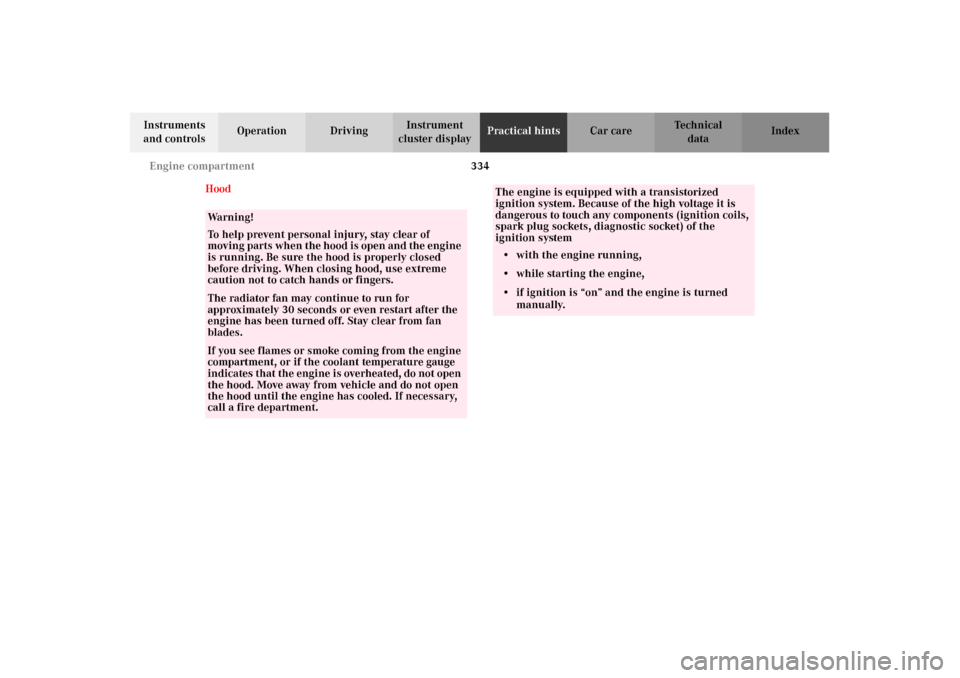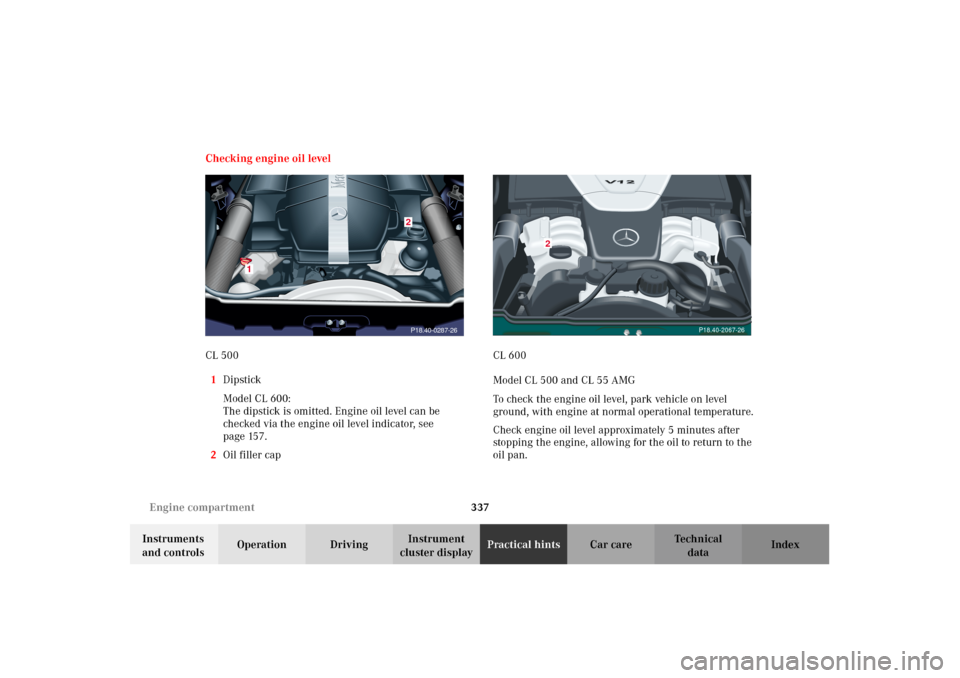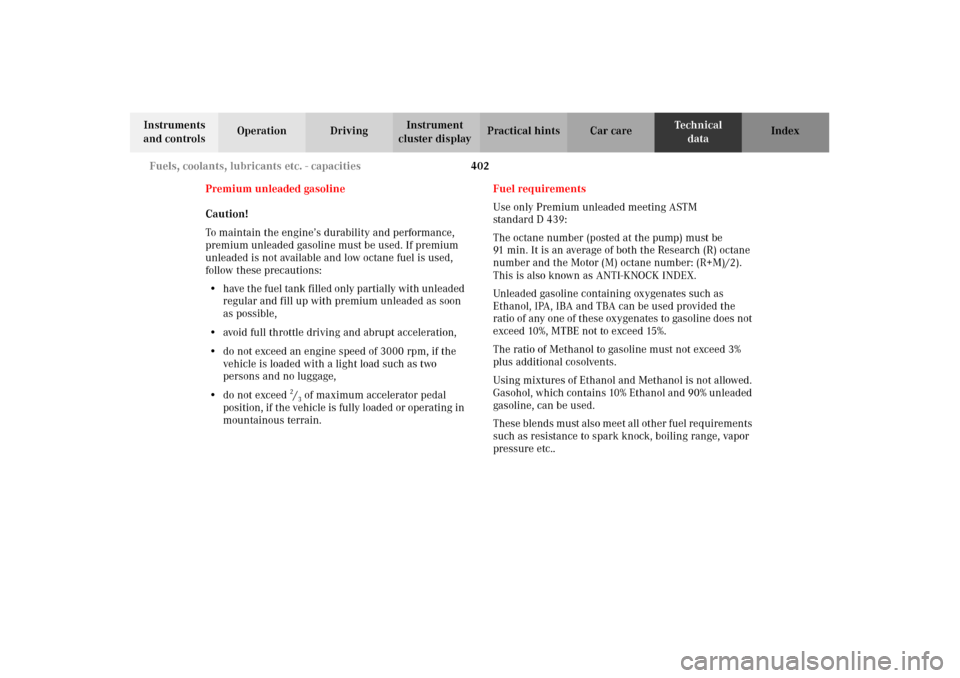2002 MERCEDES-BENZ CL600 engine oil
[x] Cancel search: engine oilPage 332 of 430

329 Contents - Practical hints
Te ch n i c a l
data Instruments
and controlsOperation DrivingInstrument
cluster displayPractical hintsCar care Index
Practical hintsFirst aid kit .....................................330
Fuses ................................................ 331
Shelf below rear window ..............333
Hood .................................................334
Checking engine oil level .............337
Automatic transmission
fluid level ...................................338
Active body control
(ABC) fluid level ........................338
Coolant level ...................................339
Adding coolant ...........................339
Windshield and headlamp
washer system ...........................340
Windshield and headlamp
washer fluid mixing ratio .........340Spare wheel, vehicle tools, storage
compartment ............................. 341
Jack .................................................. 342
Wheels ............................................ 343
Tire Replacement ....................... 343
Rotating wheels ......................... 344
Spare wheel .................................... 344
Changing wheels ........................... 346
Tire inflation pressure ................. 351
Battery ............................................. 352
Jump starting ................................. 355
Towing the vehicle ........................ 357
Exterior lamps ............................... 360
Headlamp assembly .................. 361
Taillamp assemblies .................. 364
Standby bulb function .................. 367Changing batteries
in the electronic key .................369
Synchronizing
remote control ............................ 371
Changing batteries in
the KEYLESS-GO-card ..............372
Emergency engine shut-down ..... 374
Fuel filler flap,
manual release .......................... 374
Emergency operation of
sliding/pop-up roof ...................375
Replacing wiper blades ................. 376
Roof rack .........................................378
J_OM_215.book Seite 329 Mittwoch, 30. Mai 2001 2:01 14
Page 337 of 430

334 Engine compartment
Te ch n i c a l
data Instruments
and controlsOperation DrivingInstrument
cluster displayPractical hintsCar care Index
Hood
Wa r n i n g !
To help prevent personal injury, stay clear of
moving parts when the hood is open and the engine
is running. Be sure the hood is properly closed
before driving. When closing hood, use extreme
caution not to catch hands or fingers.The radiator fan may continue to run for
approximately 30 seconds or even restart after the
engine has been turned off. Stay clear from fan
blades.If you see flames or smoke coming from the engine
compartment, or if the coolant temperature gauge
indicates that the engine is overheated, do not open
the hood. Move away from vehicle and do not open
the hood until the engine has cooled. If necessary,
call a fire department.
The engine is equipped with a transistorized
ignition system. Because of the high voltage it is
dangerous to touch any components (ignition coils,
spark plug sockets, diagnostic socket) of the
ignition system
• with the engine running,
• while starting the engine,
• if ignition is “on” and the engine is turned
manually.
J_OM_215.book Seite 334 Mittwoch, 30. Mai 2001 2:01 14
Page 340 of 430

337 Engine compartment
Te ch n i c a l
data Instruments
and controlsOperation DrivingInstrument
cluster displayPractical hintsCar care Index Checking engine oil level
CL 500
1Dipstick
Model CL 600:
The dipstick is omitted. Engine oil level can be
checked via the engine oil level indicator, see
page 157.
2Oil filler capCL 600
Model CL 500 and CL 55 AMG
To check the engine oil level, park vehicle on level
ground, with engine at normal operational temperature.
Check engine oil level approximately 5 minutes after
stopping the engine, allowing for the oil to return to the
oil pan.
1
P18.40-0287-262
P18.40-2067-26
2
J_OM_215.book Seite 337 Mittwoch, 30. Mai 2001 2:01 14
Page 341 of 430

338 Engine compartment
Te ch n i c a l
data Instruments
and controlsOperation DrivingInstrument
cluster displayPractical hintsCar care Index
The engine oil level can be checked by either the oil
dipstick or via the multifunction display in the
instrument cluster, see page 157.
Wipe the oil dipstick clean prior to checking the engine
oil level. Fully insert dipstick in tube, and remove after
three seconds to obtain accurate reading.
The oil level must be between the lower
mark (min) and the upper mark (max)
on the oil dipstick.
Unscrew the oil filler cap and add oil carefully if you
need to top up the oil.
CL 500 and CL 55 AMG:
Fill quantity between upper and lower dipstick marking
level is approximately 2.1 US qt (2.0 l).
CL 600:
Follow the message appearing on the engine oil level
indicator display (page 157) as to quantity to be added.
Re-install oil filler cap.
Do not overf ill the engine.
Excessive oil must be drained
or siphoned. It could cause damage to engine and
catalytic converter not covered by the Mercedes-Benz
Limited Warranty.See malfunction and warning messages on page 303 if
an engine oil level display appears on the multifunction
display when the engine is running.
Note:
See page 157 for engine oil level indicator.
Automatic transmission fluid level
The transmission has a permanent fill of automatic
transmission fluid.
Regular automatic transmission fluid level checks and
changes are not required. For this reason the dipstick is
omitted.
If you notice fluid leaks or gear shifting malfunctions,
have your authorized Mercedes-Benz Center check the
transmission fluid level.
Active body control (ABC) fluid level
Regular fluid level check is not required.
If you notice fluid leaks or malfunctions, have your
authorized Mercedes-Benz Center check the
ABC-system.
J_OM_215.book Seite 338 Mittwoch, 30. Mai 2001 2:01 14
Page 392 of 430

389 Contents - Technical data
Te ch n i c a l
data Instruments
and controlsOperation DrivingInstrument
cluster displayPractical hints Car care Index
Technical dataSpare parts service ........................390
Warranty coverage .........................390
Identification labels ....................... 391
Layout of poly-V-belt drive ............393
Technical data ................................394
Fuels, coolants,
lubricants etc. - capacities .......399
Engine oils ...................................... 401Engine oil additives ...................... 401
Air conditioner
refrigerant ................................. 401
Brake fluid ...................................... 401
Premium unleaded
gasoline ...................................... 402
Fuel requirements ........................ 402
Gasoline additives ......................... 403
Coolants .......................................... 403
Consumer information ................. 405
J_OM_215.book Seite 389 Mittwoch, 30. Mai 2001 2:01 14
Page 402 of 430

399 Fuels, coolants, lubricants etc. - capacities
Te ch n i c a l
data Instruments
and controlsOperation DrivingInstrument
cluster displayPractical hints Car care Index Fuels, coolants, lubricants etc. - capacities
Vehicle components and their respective lubricants must match. Therefore use only brands tested and recommended
by us. Please refer to the Factory Approved Service Products pamphlet, or inquire at your Mercedes-Benz Center.
Model Capacity Fuels, coolants, lubricants etc.
Engine with oil filter CL 500
CL 55 AMG
CL 6008.5 US qt (8.0 l)
8.0 US qt (7.5 l)
10.0 US qt (9.5 l)Recommended engine oils
Automatic transmission 9.6 US qt (9.1 l) Automatic transmission fluid
Rear axle 1.7 US qt (1.6 l) Hypoid gear oil SAE 85 W 90
Hydraulic system for
active body control (ABC)approx. 5.3 US qt (5.0 l) MB Hydraulic fluid
Power steering approx. 1.1 US qt (1.0 l) MB Power steering fluid
Front wheel hubs approx. 2.1 oz (60 g) each High temperature roller bearing grease
Brake system 0.7 US qt (0.7 l) MB Brake fluid (DOT 4+)
Cooling system CL 500
CL 55 AMG
CL 600approx. 12.1 US qt (11.5 l)
approx. 12.1 US qt (11.5 l)
approx. 12.7 US qt (12.0 l)MB Anticorrosion/antifreeze
J_OM_215.book Seite 399 Mittwoch, 30. Mai 2001 2:01 14
Page 404 of 430

401 Fuels, coolants, lubricants etc. - capacities
Te ch n i c a l
data Instruments
and controlsOperation DrivingInstrument
cluster displayPractical hints Car care Index Engine oils
Engine oils are specifically tested for their suitability in
our engines. Therefore, use only engine oils
recommended by Mercedes-Benz. Information on
recommended brands is available at your authorized
Mercedes-Benz Center.
Please follow Service Booklet recommendations for
scheduled oil changes. Failure to do so could result in
engine damage not covered by the Mercedes-Benz
Limited Warranty.
Engine oil additives
Do not blend oil additives with engine oil. They may be
harmful to the engine operation.
Damage or malfunctions resulting from blending oil
additives are not covered by the Mercedes-Benz Limited
Warranty.Air conditioner refrigerant
R-134a (HFC) refrigerant and special PAG lubricating oil
is used in the air conditioner system.
Never use R-12 (CFC) or mineral-based lubricating oil,
otherwise damage to the system will occur.
Brake fluid
During vehicle operation, the boiling point of the brake
fluid is continuously reduced through the absorption of
moisture from the atmosphere. Under extremely hard
operating conditions, this moisture content can lead to
the formation of bubbles in the system thus reducing
the system’s efficiency.
The brake fluid must therefore be replaced every two
years, preferably in the spring.
It is recommended to use only brake fluid approved by
Mercedes-Benz. Your authorized Mercedes-Benz Center
will provide you with additional information.
J_OM_215.book Seite 401 Mittwoch, 30. Mai 2001 2:01 14
Page 405 of 430

402 Fuels, coolants, lubricants etc. - capacities
Te ch n i c a l
data Instruments
and controlsOperation DrivingInstrument
cluster displayPractical hints Car care Index
Premium unleaded gasoline
Caution!
To maintain the engine’s durability and performance,
premium unleaded gasoline must be used. If premium
unleaded is not available and low octane fuel is used,
follow these precautions:
•have the fuel tank filled only partially with unleaded
regular and fill up with premium unleaded as soon
as possible,
•avoid full throttle driving and abrupt acceleration,
•do not exceed an engine speed of 3000 rpm, if the
vehicle is loaded with a light load such as two
persons and no luggage,
•do not exceed
2/3 of maximum accelerator pedal
position, if the vehicle is fully loaded or operating in
mountainous terrain.Fuel requirements
Use only Premium unleaded meeting ASTM
standard D 439:
The octane number (posted at the pump) must be
91 min. It is an average of both the Research (R) octane
number and the Motor (M) octane number: (R+M)/2).
This is also known as ANTI-KNOCK INDEX.
Unleaded gasoline containing oxygenates such as
Ethanol, IPA, IBA and TBA can be used provided the
ratio of any one of these oxygenates to gasoline does not
exceed 10%, MTBE not to exceed 15%.
The ratio of Methanol to gasoline must not exceed 3%
plus additional cosolvents.
Using mixtures of Ethanol and Methanol is not allowed.
Gasohol, which contains 10% Ethanol and 90% unleaded
gasoline, can be used.
These blends must also meet all other fuel requirements
such as resistance to spark knock, boiling range, vapor
pressure etc..
J_OM_215.book Seite 402 Mittwoch, 30. Mai 2001 2:01 14